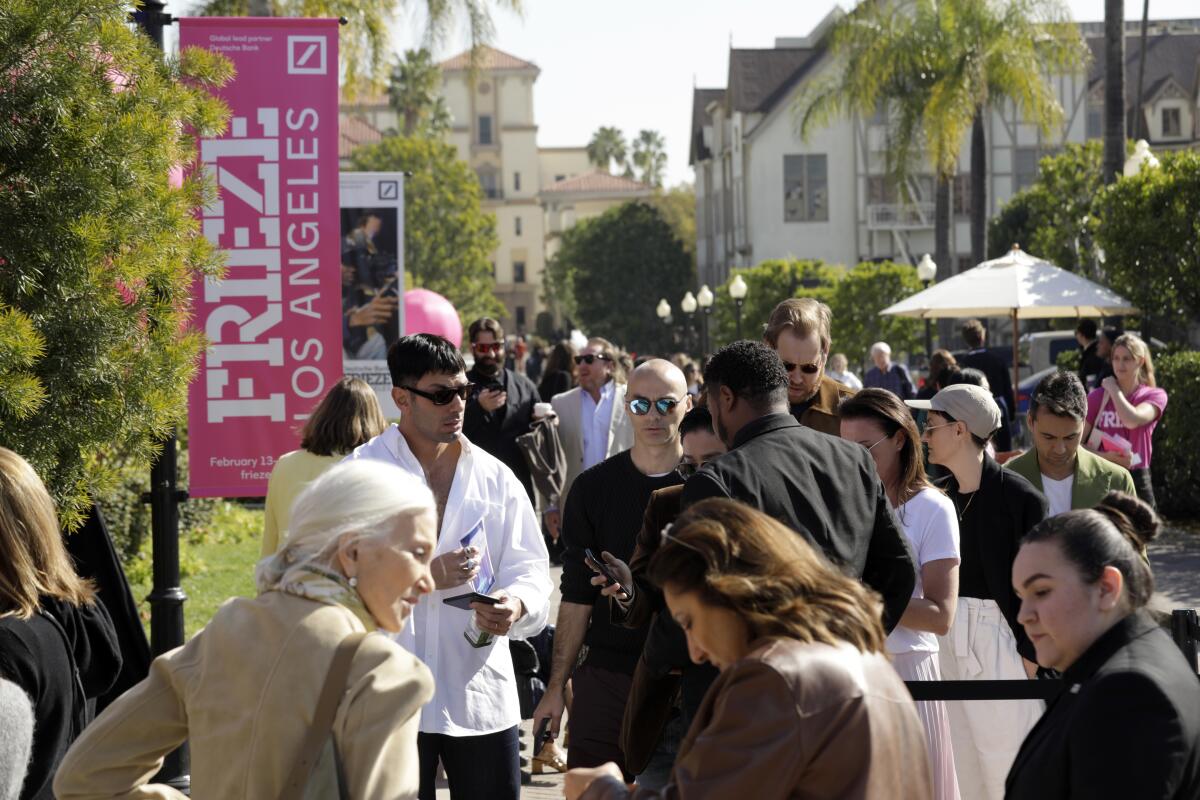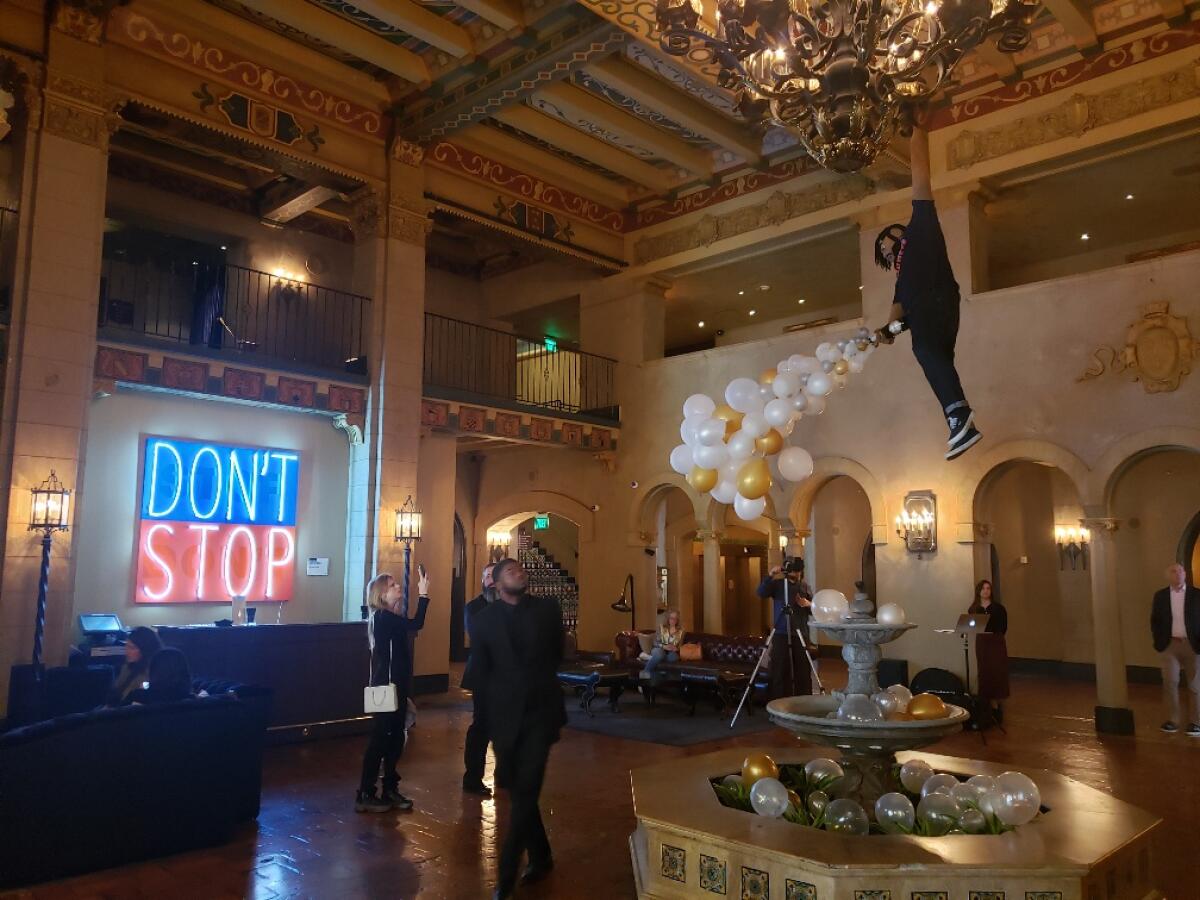Why art fair season is kicking off despite Omicron concerns
- Share via
Art fair season is upon us. But what does that mean in the season of Omicron?
The LA Art Show opens its doors on Wednesday, the first of five, large-scale, in-person art fairs taking place through late February in the region. Even as Omicron surges, and as many live cultural events cancel or reschedule — including the Grammy Awards, the Palm Springs International Film Festival and performances, through Feb. 9, of “Hamilton” at the Pantages Theatre — the prevailing sentiment in the art fair world appears to be: the show must go on.
“Once again, we need a physical art fair in Los Angeles to bring the creative community back together,” LA Art Show director Kassandra Voyagis tells The Times via email. “We are following all city and CDC protocols to ensure not only a safe space, but a comfortable space to kick off the 2022 LA art season.”
But comfortable is relative. We’re in a particularly individualized — and for many, a confusing — moment with regard to the pandemic. To socialize or isolate? To eat indoors or outdoors? To hold live events, cancel or wait and see? As public health guidelines continue to evolve and pandemic fatigue further sets in, the widely varying perspectives on personal and institutional safety add up to something of a “choose your own adventure” approach.
The LA Art Show says it has taken extra care with COVID precautions. Now in its 27th year and featuring 70 galleries from around the country and internationally, the fair will take over the largest exhibition hall at the downtown L.A. Convention Center, with 180,000 square feet of space. At the same time, it has limited capacity by 50%; it’s expecting about 30,000 visitors over five days as opposed to its pre-pandemic average of about 60,000 over four days. Attendees will have to show proof of full vaccination or a recent negative COVID test result.
“On the heels of our successfully executed L.A. show just six months ago,” Voyagis says of a pared-back iteration of the fair in July, “we were fortunate enough to enter the planning phase with real life experience as to how to keep our attendees, galleries, museums, and staff safe.”
Still, some art fair directors, such as StARTup LA’s Ray Beldner, feel an in-person event in the age of Omicron is “too dicey.”
“I totally understand why people need to resume their businesses. Everybody’s gotta do what they gotta do,” Beldner says. “But I certainly wouldn’t do it — it doesn’t seem safe enough yet.”
StARTup LA, which features emerging and independent artists not represented by galleries, would normally be part of this year’s art fair bonanza — it’s held five fairs over the years before the pandemic. But StARTup LA won’t be taking place this year, nor did it hold an event late last year, as it had considered — the latter a decision Beldner says he came to after surveying a sampling of his fair’s exhibitor alums that spring.
“They 100% said no,” he says. “I don’t think there’s going to be a good enough crowd [this year] with good enough sales to justify the risk to artists and the public.”
In February, the art fair scene heats up. Intersect Palm Springs will take place Feb. 10-13; the following week, Frieze Los Angeles, Felix LA and Spring Break Los Angeles run concurrently from Feb. 17-20. Art Los Angeles Contemporary will not be taking place this spring. “The scope and scale of ALAC is shifting,” says ALAC founder Tim Fleming, “and exactly when that will take place, we’ll be announcing soon.”
Typically this weeklong coagulation of art fairs in mid-February — dubbed Frieze Week — draws art makers, sellers, collectors and spectators from around the globe, which in turn spawns parties, performances, art talks and other Prosecco-infused art happenings citywide.
Frieze Week will undoubtedly look different this year, with more intimate parties and outdoor happenings; but some galleries are still wary.
“It’s a little soon for us to be participating,” says Eva Chimento, director of the West Adams gallery Band of Vices. “I do think the fairs are being extremely careful. But when everyone came back from Miami Basel [in December] — I didn’t go because of the variant — I can’t tell you how many people, among my friends and colleagues, had COVID. Artists, dealers, collectors.”
Jeffrey Deitch says his New York- and L.A.-based gallery, Jeffrey Deitch, had “no issues” during Art Basel Miami Beach last month and will be exhibiting at Frieze Los Angeles in February. “The pandemic is the new normal,” he says. “It could go on for some time and we can’t shut down our lives and professions. We just have to adapt in a safe and prudent way.”

Drawing out-of-town crowds isn’t something Frieze is concerned about. Frieze Los Angeles director Christine Messineo says the art fair is expecting its typical 35,000 attendees over four days. Gallery participation is at an all-time high — more than 100 exhibitors as opposed to about 70 in previous L.A. iterations — with no participants having dropped out yet despite mounting Omicron infection rates.
“There’s a general kind of excitement for the show to continue,” Messineo says. “I’m continuing to get emails being, like, ‘Is there an opening? Can I participate still?’”
This year, Frieze Los Angeles is relocating from Hollywood’s Paramount Pictures Studios to an enclosed tent in a lot next to the Beverly Hilton. The tent is 40% larger than the Paramount tent and, among the safety protocols, a timed entry system will limit capacity at any given time and regulate the flow of foot traffic. The fair is also spotlighting outdoor programming, with a free sculpture exhibition taking place, for the first time in L.A., at Beverly Gardens Park.
Frieze’s focus on the local art scene — 40% of exhibiting galleries are from L.A. this year — is “working to our advantage right now,” Messineo says, adding “They’re here and they’re present, it’s not like they have to travel as far.”
Last week Frieze announced that its board director, Victoria Siddall, who’d been with the company for 18 years, unexpectedly departed. She’ll stay on through the end of the L.A. fair and her exit, Messineo says, was “not related at all” to pandemic challenges. “She has been such a longtime supporter and employee and crucial member of Frieze for so long,” Messineo says. “She’s not disappearing completely, she’s remaining on the board at Frieze.”

Art fairs are logistically complicated events in the best of times. Art must be shipped from other countries, programming planned and physical exhibition spaces built out, which requires construction materials and labor. All of which could be slowed by possible supply chain issues or staffing shortages.
So is Omicron complicating preparations as the fairs ready to open?
Dean Valentine, co-founder of Felix — held at the Hollywood Roosevelt hotel — says the fair isn’t experiencing Omicron-related delays. But there “are concerns,” he says.
“The biggest thing we’re concerned about is that our fair operates in a hotel and the hotel has occasional staffing challenges. We need to make sure that they can accommodate the many, many people coming.”
Felix cancelled its February 2021 show and instead held a scaled-back version for 29 local galleries by the hotel pool in July. It is returning to its pre-COVID format this year. That means 60 local and international galleries exhibiting in open-air cabanas around the pool as well as inside hotel rooms across two floors. It plans to limit indoor capacity, increase ventilation and require proof of double vaccination and boosters, among other safety protocols.
“We made a studied decision,” Valentine says, “that there was a very, very good chance that by the time Felix and Frieze happened in mid-end of February, we’d be on the other side of the Omicron pandemic.”
If the virus becomes more aggressive, according to CDC guidelines, Valentine adds, Felix would likely cancel. “People need their lives more than they need art,” he says. “But I don’t believe that that’s what the choice is right now.”
Since the pandemic, Sprüth Magers gallery has reduced the number of international art fairs it’s participating in — but Frieze Los Angeles will decidedly be one of them. “It feels important to do Frieze because it’s a moment of outreach,” says Marta Fontolan, a senior director at the L.A. outpost of the gallery. “We have shows coming up and the art fairs function in a promotional way. We want to make sure our presence is seen.”
Supporting the city is a key reason David Kordansky Gallery is participating in Frieze, says one of its directors, Kurt Mueller. “As an L.A.-based gallery, it’s very important to us to support the local ecosystem, and Frieze L.A. has become part of that. It’s helped advance L.A. as a global art capital — their success is L.A.’s success and our success.”
Not everyone is partaking. Santa Monica-based William Turner Gallery is not participating in any of this year’s local art fairs. “We’ve done fairs before, but we take it on a case by case, year to year basis,” William Turner says. “They’re enough of a financial commitment that given the vagaries of how this pandemic will unfold, we’ve held back. There’s so much competition around the fairs that you can have a great show and the returns are still unpredictable. When you factor in COVID, that’s another layer of unpredictability.”
Ultimately, there’s value in an art fair’s ability to galvanize community and provide a sense of normalcy, Frieze’s Messineo says.
“We saw it in New York when we did Frieze New York [in May]: There’s this sense of community-building,” she says. “And something transformative happens when we look at art in person.”
That “social purpose,” Valentine adds, couldn’t be more timely.
“Part of what contemporary art is about are those conversations about art,” he says. “Now more than ever that’s important — not more than public health, but important.”
More to Read
The biggest entertainment stories
Get our big stories about Hollywood, film, television, music, arts, culture and more right in your inbox as soon as they publish.
You may occasionally receive promotional content from the Los Angeles Times.











